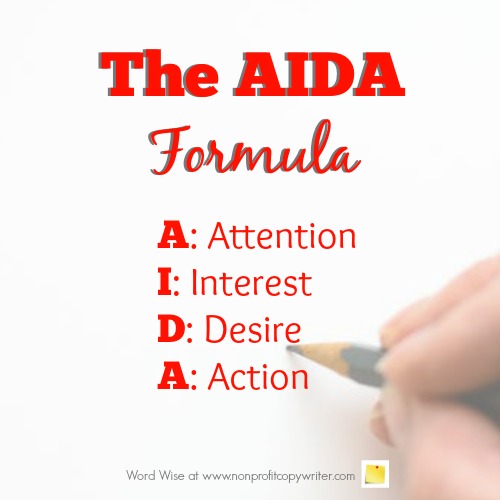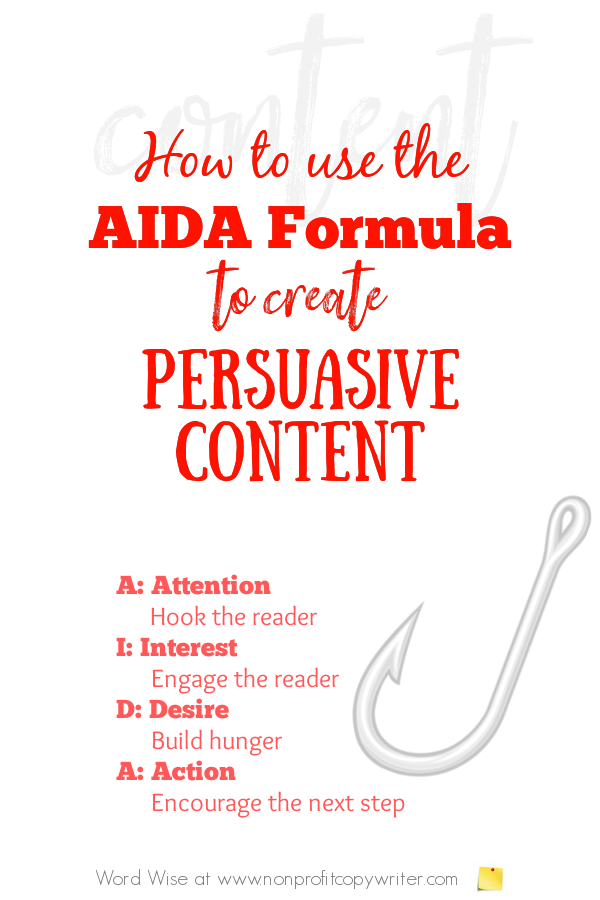Save Time: Get 5 Simple Writing Tips
you can put to use in 10 minutes
Use the AIDA Formula for Writing Persuasive Content
Award-winning writer Kathy Widenhouse has helped hundreds of nonprofits and writers produce successful content , with 750K+ views for her writing tutorials. She is the author of 9 books. See more of Kathy’s content here.
Updated 10.16.24
The AIDA formula started its life as a tried-and-true advertising model. It is a framework credited to American advertising pioneer Elias St. Elmo Lewis (1872-1948).
Little did I know that we writers hijacked the formula from marketers.
But I find it handy for writing all kinds of content, especially for writing articles, web pages, and blog posts.
I'll explain how in just a sec. But first, a bit of
background.
What Is the AIDA Formula?
The formula outlines 4 stages a consumer goes through when
making a purchasing decision.
Those 4 stages are …
- A: Attention. Grab the reader’s attention with an interesting fact, story, statistic, or startling statement about a problem and the need for a solution.
- I: Interest. Keep the reader’s interest by explaining the need or the problem further – and why your organization or product is the answer to the problem.
- D: Desire. Build the reader’s desire to alleviate the problem by outlining the benefits of your product, service, or cause.
- A: Action. Move the reader to in a call to action with clear instructions about what she should do, such as buying a product now or giving a gift before it is too late.
A consumer becomes aware of then product, then develops interest in its benefits, cultivates a desire for it, and finally takes action to buy it. If you stop and think about it, you’ve experienced these 4 stages for yourself, like this:
- You need a sweater. An advertisement from your favorite department store captures your attention.
- The flyer indicates the store is having a sale, which raises your interest.
- You notice a cardigan sweater with a cable design that’s part of the sale. You’ve wanted one all year. Now, your desire is piqued.
- And you see that the sweater is available for purchase online. So you take action and click “Buy.”
The formula worked so well in persuading consumers to consume that it’s been seized by content writers.
Can the 100-year-old AIDA formula work for content writing?
Yes. In fact, I’d argue that it’s become one of the top templates you can use for any kind of content.
The reason is simple. The rise of the internet and digital marketing transformed writing.
Even copywriters are no longer focused solely on print and broadcast, but online content. Websites, emails, landing pages, blog posts, downloads, free reports, case studies, tip sheets – writing to persuade is now central to all kinds of content both online and off.
Used to be in the early to mid 1900s, advertisers relied on billboards, print ads, and direct mail. During that time, the AIDA formula was born and flourished. But then the internet took over, and …
- Content marketing surged. As the internet grew in the 1990s-early 2000s, content marketing became a powerful way to attract and engage audiences. Businesses started to use blog posts, articles, white papers, and social media to create persuasive content. Soon, the line between content and copywriting blurred, with writers tasked not only with selling but also with educating and engaging audiences over time. The AIDA formula was a perfect fit. The framework helped writers focus on getting readers’ attention and creating actionable content.
- Online copywriting became a specialty. Copywriting, of course, is writing to sell. As the internet grew, so did the demand for online content like websites, sales pages, email campaigns, and product descriptions – all designed to move a reader to act. Why not borrow the framework that was so successful in print material? Writers realized that good copy not only informed but also persuaded. AIDA’s structured approach guides readers from initial awareness to a final call to action.
- Persuasive storytelling became standard. As businesses joined social media, they realized that simply promoting products didn’t work—they had to tell stories that people could connect with and share. Writers adopted the AIDA model as a workable structure. You can use it to hook readers with a story from the beginning, keep them engaged and interested, build an emotional desire to connect or learn more, and encourage them to act—whether it’s making a purchase, clicking a link, posting a comment, or sharing content.
- User experience became paramount. Online audiences have become selective. Attention spans are shorter. Writers need to craft content that quickly captures a reader’s attention and lead them through a smooth and engaging experience. AIDA’s structure fits this requirement perfectly. It leads a user through a clear, persuasive flow from start to finish.
How to Use AIDA in Your Content Writing
“But AIDA is designed to persuade, so using it in sales letters and other copywriting makes sense,” you say. “But to use a persuasive framework in content writing seems disingenuous, when I simply want to provide information the reader can use.”
I felt the same way … until I realized that the purpose of content writing is to give the reader information she can use or act on.
Good content is about ...
- Getting the reader’s attention about a problem (A)
- Keeping her interest by explaining her problem (I)
- Building a desire for a solution (D)
- Giving her an action to take. (A).
Content explains a problem and a solution. Ultimately, good content gives the reader an action to take to solve her problem. Likewise, getting the reader to act is AIDA’s ultimate goal. "Action" is the fourth step of the formula's 4-part framework.
Here’s what AIDA looks like in your next piece of content
1. Attention: Hook the reader
Start
with a strong headline or opening statement: Use a powerful hook to
grab the reader’s attention immediately. This could be a surprising fact,
an intriguing question, or a bold statement that resonates with your
audience’s needs or desires.
Examples:
- "Did you know 80% of businesses fail because they don’t prioritize their website content?"
- "What if I told you there’s a way to double your organic traffic in 30 days?"
- “The AIDA formula is widely used model in copywriting. But I find it handy for writing all kinds of content – not just sales materials. I use the formula for writing articles, web pages, and blog posts.”
2. Interest: Keep the reader engaged
Present
the problem: Once you have their attention, dive deeper into a topic
that matters to your audience. Address a pain point or challenge they face
or provide insight into something they care about.
Provide value: Offer solutions, tips, or compelling reasons to keep reading. You can use stories, case studies, or relevant data to build interest.
Examples:
- “Every small business wants more traffic, but most aren’t sure where to start. With the right content strategy, you can drive consistent visitors without paying for ads.”
- “What is the AIDA formula? How is it used in marketing – and now, in content writing?”
3. Desire: Build hunger
Show how your solution meets their needs: Highlight the benefits of the product, service, or idea you’re presenting. Use emotional and logical appeals to make the reader want what you’re offering.
Use stories and testimonials: Share examples of how others have benefited or succeeded using your approach. Position the solution as something desirable and within reach.
Examples:
- “Imagine your website ranking on the first page of Google, attracting a steady stream of customers—without spending a fortune on ads.”
- "Many businesses, like yours, have doubled their leads with just these three simple strategies."
- “Yes, you can use the AIDA formula in content writing. In fact, I’d argue that it’s become one of the top templates you can use for any kind of content.”
4. Action: Encourage the next step
Include
a clear call-to-action (CTA): After building desire, guide your
readers toward a specific action. This could be subscribing to a
newsletter, signing up for a free trial, downloading a guide, or
purchasing a product.
Use scarcity : Create a sense of urgency to motivate readers to act now rather than later.
Examples:
- “Ready to boost your website traffic? Download our free SEO checklist today!”
- “Don’t miss out—sign up for our webinar now to learn the exact steps to grow your business.”
- “Ultimately, good content gives the reader an action to take to solve her problem. Getting the reader to act is AIDA’s ultimate goal. Here’s what using the formula looks like in your next piece of content.”
How to use the AIDA formula for different kinds of content
Blog posts
- Start with an attention-grabbing headline.
- Then, explain why the topic matters.
- Show the benefits of your solution or tips.
- End with a call to action that leads readers to subscribe, comment, or apply what they’ve learned.
Landing pages
- Capture attention with a headline that speaks to the audience’s needs.
- Present the benefits of your product or service.
- Build desire through testimonials or case studies.
- Close with a persuasive call to action, like “Buy Now” or “Start Free Trial.”
Email campaigns
- Hook the reader with a compelling subject line.
- Engage them with a story or useful tip at the top of the email.
- Convince them, with a bit of explanation or sense of urgency, to crave the offer or service.
- Wrap up with a call to action that directs them to click a link or reply.
Use the AIDA formula to get your readers to act
Good content provides information the reader needs. Persuasive content goes further. It motivates your reader to use the information.
By nature, we humans are lazy. It’s easier for us to maintain the status quo rather than make a change, respond, or even take a simple step.
That makes AIDA a helpful formula for all kinds of content. It gives you a proven framework that leads readers through the process of change.
It gives your readers what they need to act.
More about Copywriting Formulas
The 1-2-3-4 Copywriting Formula: answer 4 simple questions for great content....
The PAS Copywriting Formula: It’s Especially Good for Social Media ...
Star-Chain-Hook: A Simple (and Persuasive) Content Writing Formula ...
Understanding Writing Formulas: why they work and when to use them ...
3 Appeal Letter Copywriting Formulas...
Bob Stone's 7-Step Copywriting Formula ...
The 4 Ps: a writing formula and a persuasive writing tool ...
The SELWAB Formula: great for writing leads and headlines ...
5 Proven Headline Formulas ...
6 Elements in a Successful Appeal Letter Formula ...
Formulas for Writing: the 2 kinds of categories they're grouped into ...
More tips for using writing formulas on our Pinterest board ...
Return from The AIDA Formula to Nonprofit Copywriter home
As an Amazon Associate I earn from qualifying purchases.
Share This Page

Named to 2022 Writer's Digest list
BEST GENRE/NICHE WRITING WEBSITE


Stop Wasting Time!
Grab your exclusive FREE guide, "5 Simple Writing Tips You Can Put to Use in 10 Minutes or Less"













